[English] 日本語
 Yorodumi
Yorodumi- PDB-8rw1: Structure of a yeast 48S-AUC preinitiation complex in closed conf... -
+ Open data
Open data
- Basic information
Basic information
| Entry | Database: PDB / ID: 8rw1 | |||||||||
|---|---|---|---|---|---|---|---|---|---|---|
| Title | Structure of a yeast 48S-AUC preinitiation complex in closed conformation | |||||||||
 Components Components |
| |||||||||
 Keywords Keywords | RIBOSOME / translation / initiation factors / 40S / eIF1A / AUC codon / eIF2 / tRNAi / 48S PIC / small ribosome subunit | |||||||||
| Function / homology |  Function and homology information Function and homology informationformation of translation initiation ternary complex / Recycling of eIF2:GDP / Cellular response to mitochondrial stress / ABC-family proteins mediated transport / methionyl-initiator methionine tRNA binding / translation reinitiation / eukaryotic translation initiation factor 2 complex / formation of cytoplasmic translation initiation complex / multi-eIF complex / eukaryotic 43S preinitiation complex ...formation of translation initiation ternary complex / Recycling of eIF2:GDP / Cellular response to mitochondrial stress / ABC-family proteins mediated transport / methionyl-initiator methionine tRNA binding / translation reinitiation / eukaryotic translation initiation factor 2 complex / formation of cytoplasmic translation initiation complex / multi-eIF complex / eukaryotic 43S preinitiation complex / formation of translation preinitiation complex / eukaryotic 48S preinitiation complex / positive regulation of translational fidelity / protein-synthesizing GTPase / GDP-dissociation inhibitor activity / Formation of the ternary complex, and subsequently, the 43S complex / Translation initiation complex formation / Ribosomal scanning and start codon recognition / Formation of a pool of free 40S subunits / L13a-mediated translational silencing of Ceruloplasmin expression / ribosomal small subunit binding / 90S preribosome / ribosomal subunit export from nucleus / endonucleolytic cleavage in ITS1 to separate SSU-rRNA from 5.8S rRNA and LSU-rRNA from tricistronic rRNA transcript (SSU-rRNA, 5.8S rRNA, LSU-rRNA) / translation regulator activity / translation initiation factor binding / translation initiation factor activity / cellular response to amino acid starvation / maturation of LSU-rRNA from tricistronic rRNA transcript (SSU-rRNA, 5.8S rRNA, LSU-rRNA) / maturation of SSU-rRNA from tricistronic rRNA transcript (SSU-rRNA, 5.8S rRNA, LSU-rRNA) / maturation of SSU-rRNA / small-subunit processome / translational initiation / cytoplasmic stress granule / rRNA processing / double-stranded RNA binding / ribosome binding / ribosomal small subunit biogenesis / ribosomal small subunit assembly / small ribosomal subunit / small ribosomal subunit rRNA binding / cytosolic small ribosomal subunit / cytoplasmic translation / rRNA binding / structural constituent of ribosome / ribosome / translation / G protein-coupled receptor signaling pathway / ribonucleoprotein complex / GTPase activity / mRNA binding / protein kinase binding / GTP binding / nucleolus / RNA binding / zinc ion binding / nucleus / cytoplasm / cytosol Similarity search - Function | |||||||||
| Biological species |   Kluyveromyces lactis NRRL Y-1140 (yeast) Kluyveromyces lactis NRRL Y-1140 (yeast) Kluyveromyces lactis (yeast) Kluyveromyces lactis (yeast) | |||||||||
| Method | ELECTRON MICROSCOPY / single particle reconstruction / cryo EM / Resolution: 3.35 Å | |||||||||
 Authors Authors | Villamayor-Belinchon, L. / Sharma, P. / Llacer, J.L. / Hussain, T. | |||||||||
| Funding support |  Spain, Spain,  India, 2items India, 2items
| |||||||||
 Citation Citation |  Journal: Nucleic Acids Res / Year: 2024 Journal: Nucleic Acids Res / Year: 2024Title: Structural basis of AUC codon discrimination during translation initiation in yeast. Authors: Laura Villamayor-Belinchón / Prafful Sharma / Yuliya Gordiyenko / Jose L Llácer / Tanweer Hussain /    Abstract: In eukaryotic translation initiation, the 48S preinitiation complex (PIC) scans the 5' untranslated region of mRNAs to search for the cognate start codon (AUG) with assistance from various ...In eukaryotic translation initiation, the 48S preinitiation complex (PIC) scans the 5' untranslated region of mRNAs to search for the cognate start codon (AUG) with assistance from various eukaryotic initiation factors (eIFs). Cognate start codon recognition is precise, rejecting near-cognate codons with a single base difference. However, the structural basis of discrimination of near-cognate start codons was not known. We have captured multiple yeast 48S PICs with a near-cognate AUC codon at the P-site, revealing that the AUC codon induces instability in the codon-anticodon at the P-site, leading to a disordered N-terminal tail of eIF1A. Following eIF1 dissociation, the N-terminal domain of eIF5 fails to occupy the vacant eIF1 position, and eIF2β becomes flexible. Consequently, 48S with an AUC codon is less favourable for initiation. Furthermore, we observe hitherto unreported metastable states of the eIF2-GTP-Met-tRNAMet ternary complex, where the eIF2β helix-turn-helix domain may facilitate eIF5 association by preventing eIF1 rebinding to 48S PIC. Finally, a swivelled head conformation of 48S PIC appears crucial for discriminating incorrect and selection of the correct codon-anticodon pair during translation initiation. | |||||||||
| History |
|
- Structure visualization
Structure visualization
| Structure viewer | Molecule:  Molmil Molmil Jmol/JSmol Jmol/JSmol |
|---|
- Downloads & links
Downloads & links
- Download
Download
| PDBx/mmCIF format |  8rw1.cif.gz 8rw1.cif.gz | 1.9 MB | Display |  PDBx/mmCIF format PDBx/mmCIF format |
|---|---|---|---|---|
| PDB format |  pdb8rw1.ent.gz pdb8rw1.ent.gz | 1.5 MB | Display |  PDB format PDB format |
| PDBx/mmJSON format |  8rw1.json.gz 8rw1.json.gz | Tree view |  PDBx/mmJSON format PDBx/mmJSON format | |
| Others |  Other downloads Other downloads |
-Validation report
| Arichive directory |  https://data.pdbj.org/pub/pdb/validation_reports/rw/8rw1 https://data.pdbj.org/pub/pdb/validation_reports/rw/8rw1 ftp://data.pdbj.org/pub/pdb/validation_reports/rw/8rw1 ftp://data.pdbj.org/pub/pdb/validation_reports/rw/8rw1 | HTTPS FTP |
|---|
-Related structure data
| Related structure data |  19541MC 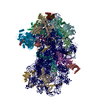 8s8dC 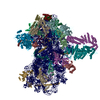 8s8eC 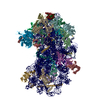 8s8fC  8s8gC 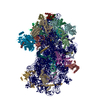 8s8hC 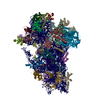 8s8iC  8s8jC  8s8kC M: map data used to model this data C: citing same article ( |
|---|---|
| Similar structure data | Similarity search - Function & homology  F&H Search F&H Search |
- Links
Links
- Assembly
Assembly
| Deposited unit | 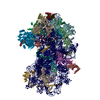
|
|---|---|
| 1 |
|
- Components
Components
-RNA chain , 3 types, 3 molecules 231
| #1: RNA chain | Mass: 579454.875 Da / Num. of mol.: 1 / Source method: isolated from a natural source / Source: (natural)  Kluyveromyces lactis NRRL Y-1140 (yeast) Kluyveromyces lactis NRRL Y-1140 (yeast) |
|---|---|
| #37: RNA chain | Mass: 15304.940 Da / Num. of mol.: 1 / Source method: obtained synthetically / Source: (synth.)  Kluyveromyces lactis (yeast) Kluyveromyces lactis (yeast) |
| #38: RNA chain | Mass: 24713.969 Da / Num. of mol.: 1 / Source method: isolated from a natural source / Source: (natural)  |
-Small ribosomal subunit protein ... , 11 types, 11 molecules ABCGOWQUcdf
| #2: Protein | Mass: 28264.525 Da / Num. of mol.: 1 / Source method: isolated from a natural source / Source: (natural)  Kluyveromyces lactis NRRL Y-1140 (yeast) / Strain: ATCC 8585 / References: UniProt: Q6CN12 Kluyveromyces lactis NRRL Y-1140 (yeast) / Strain: ATCC 8585 / References: UniProt: Q6CN12 |
|---|---|
| #3: Protein | Mass: 28971.643 Da / Num. of mol.: 1 / Source method: isolated from a natural source / Source: (natural)  Kluyveromyces lactis NRRL Y-1140 (yeast) / References: UniProt: Q6CWD0 Kluyveromyces lactis NRRL Y-1140 (yeast) / References: UniProt: Q6CWD0 |
| #4: Protein | Mass: 27649.979 Da / Num. of mol.: 1 / Source method: isolated from a natural source / Source: (natural)  Kluyveromyces lactis NRRL Y-1140 (yeast) / References: UniProt: Q6CKL3 Kluyveromyces lactis NRRL Y-1140 (yeast) / References: UniProt: Q6CKL3 |
| #6: Protein | Mass: 26970.391 Da / Num. of mol.: 1 / Source method: isolated from a natural source / Source: (natural)  Kluyveromyces lactis NRRL Y-1140 (yeast) / References: UniProt: Q6CM04 Kluyveromyces lactis NRRL Y-1140 (yeast) / References: UniProt: Q6CM04 |
| #12: Protein | Mass: 14530.655 Da / Num. of mol.: 1 / Source method: isolated from a natural source / Source: (natural)  Kluyveromyces lactis NRRL Y-1140 (yeast) / References: UniProt: P27069 Kluyveromyces lactis NRRL Y-1140 (yeast) / References: UniProt: P27069 |
| #14: Protein | Mass: 14645.041 Da / Num. of mol.: 1 / Source method: isolated from a natural source / Source: (natural)  Kluyveromyces lactis NRRL Y-1140 (yeast) / References: UniProt: Q6CW21 Kluyveromyces lactis NRRL Y-1140 (yeast) / References: UniProt: Q6CW21 |
| #26: Protein | Mass: 15874.531 Da / Num. of mol.: 1 / Source method: isolated from a natural source / Source: (natural)  Kluyveromyces lactis NRRL Y-1140 (yeast) / References: UniProt: Q875N2 Kluyveromyces lactis NRRL Y-1140 (yeast) / References: UniProt: Q875N2 |
| #30: Protein | Mass: 13337.604 Da / Num. of mol.: 1 / Source method: isolated from a natural source / Source: (natural)  Kluyveromyces lactis NRRL Y-1140 (yeast) / References: UniProt: Q6CIM1 Kluyveromyces lactis NRRL Y-1140 (yeast) / References: UniProt: Q6CIM1 |
| #32: Protein | Mass: 7549.824 Da / Num. of mol.: 1 / Source method: isolated from a natural source / Source: (natural)  Kluyveromyces lactis NRRL Y-1140 (yeast) / References: UniProt: P33285 Kluyveromyces lactis NRRL Y-1140 (yeast) / References: UniProt: P33285 |
| #33: Protein | Mass: 6662.570 Da / Num. of mol.: 1 / Source method: isolated from a natural source / Source: (natural)  Kluyveromyces lactis NRRL Y-1140 (yeast) / References: UniProt: Q6CPG3 Kluyveromyces lactis NRRL Y-1140 (yeast) / References: UniProt: Q6CPG3 |
| #34: Protein | Mass: 17110.977 Da / Num. of mol.: 1 / Source method: isolated from a natural source / Source: (natural)  Kluyveromyces lactis NRRL Y-1140 (yeast) / References: UniProt: P69061 Kluyveromyces lactis NRRL Y-1140 (yeast) / References: UniProt: P69061 |
-40S ribosomal protein ... , 12 types, 12 molecules EHIVYabehDMZ
| #5: Protein | Mass: 29617.514 Da / Num. of mol.: 1 / Source method: isolated from a natural source / Source: (natural)  Kluyveromyces lactis NRRL Y-1140 (yeast) / References: UniProt: Q6CWJ2 Kluyveromyces lactis NRRL Y-1140 (yeast) / References: UniProt: Q6CWJ2 |
|---|---|
| #7: Protein | Mass: 21735.297 Da / Num. of mol.: 1 / Source method: isolated from a natural source / Source: (natural)  Kluyveromyces lactis NRRL Y-1140 (yeast) / References: UniProt: Q6CTD6 Kluyveromyces lactis NRRL Y-1140 (yeast) / References: UniProt: Q6CTD6 |
| #8: Protein | Mass: 22642.727 Da / Num. of mol.: 1 / Source method: isolated from a natural source / Source: (natural)  Kluyveromyces lactis NRRL Y-1140 (yeast) / References: UniProt: Q6CMG3 Kluyveromyces lactis NRRL Y-1140 (yeast) / References: UniProt: Q6CMG3 |
| #13: Protein | Mass: 9797.949 Da / Num. of mol.: 1 / Source method: isolated from a natural source / Source: (natural)  Kluyveromyces lactis NRRL Y-1140 (yeast) / References: UniProt: Q6CXT6 Kluyveromyces lactis NRRL Y-1140 (yeast) / References: UniProt: Q6CXT6 |
| #16: Protein | Mass: 15194.549 Da / Num. of mol.: 1 / Source method: isolated from a natural source / Source: (natural)  Kluyveromyces lactis NRRL Y-1140 (yeast) / References: UniProt: Q6CU44 Kluyveromyces lactis NRRL Y-1140 (yeast) / References: UniProt: Q6CU44 |
| #17: Protein | Mass: 13539.957 Da / Num. of mol.: 1 / Source method: isolated from a natural source / Source: (natural)  Kluyveromyces lactis NRRL Y-1140 (yeast) / References: UniProt: Q6CS01 Kluyveromyces lactis NRRL Y-1140 (yeast) / References: UniProt: Q6CS01 |
| #18: Protein | Mass: 8884.362 Da / Num. of mol.: 1 / Source method: isolated from a natural source / Source: (natural)  Kluyveromyces lactis NRRL Y-1140 (yeast) / References: UniProt: Q6CNL2 Kluyveromyces lactis NRRL Y-1140 (yeast) / References: UniProt: Q6CNL2 |
| #19: Protein | Mass: 7141.421 Da / Num. of mol.: 1 / Source method: isolated from a natural source / Source: (natural)  Kluyveromyces lactis NRRL Y-1140 (yeast) / References: UniProt: Q6CUH5 Kluyveromyces lactis NRRL Y-1140 (yeast) / References: UniProt: Q6CUH5 |
| #20: Protein/peptide | Mass: 3354.243 Da / Num. of mol.: 1 / Source method: isolated from a natural source / Source: (natural)  Kluyveromyces lactis NRRL Y-1140 (yeast) Kluyveromyces lactis NRRL Y-1140 (yeast) |
| #21: Protein | Mass: 26300.535 Da / Num. of mol.: 1 / Source method: isolated from a natural source / Source: (natural)  Kluyveromyces lactis NRRL Y-1140 (yeast) / References: UniProt: Q6CRK7 Kluyveromyces lactis NRRL Y-1140 (yeast) / References: UniProt: Q6CRK7 |
| #24: Protein | Mass: 14466.398 Da / Num. of mol.: 1 / Source method: isolated from a natural source / Source: (natural)  Kluyveromyces lactis NRRL Y-1140 (yeast) / References: UniProt: Q6CLU4 Kluyveromyces lactis NRRL Y-1140 (yeast) / References: UniProt: Q6CLU4 |
| #31: Protein | Mass: 12002.116 Da / Num. of mol.: 1 / Source method: isolated from a natural source / Source: (natural)  Kluyveromyces lactis NRRL Y-1140 (yeast) / References: UniProt: Q6CW78 Kluyveromyces lactis NRRL Y-1140 (yeast) / References: UniProt: Q6CW78 |
-Protein , 12 types, 12 molecules JLNXFKPRSTgi
| #9: Protein | Mass: 21587.049 Da / Num. of mol.: 1 / Source method: isolated from a natural source / Source: (natural)  Kluyveromyces lactis NRRL Y-1140 (yeast) / References: UniProt: Q6CM18 Kluyveromyces lactis NRRL Y-1140 (yeast) / References: UniProt: Q6CM18 |
|---|---|
| #10: Protein | Mass: 17843.930 Da / Num. of mol.: 1 / Source method: isolated from a natural source / Source: (natural)  Kluyveromyces lactis NRRL Y-1140 (yeast) / References: UniProt: Q6CX80 Kluyveromyces lactis NRRL Y-1140 (yeast) / References: UniProt: Q6CX80 |
| #11: Protein | Mass: 16989.875 Da / Num. of mol.: 1 / Source method: isolated from a natural source / Source: (natural)  Kluyveromyces lactis NRRL Y-1140 (yeast) / References: UniProt: Q6CJK0 Kluyveromyces lactis NRRL Y-1140 (yeast) / References: UniProt: Q6CJK0 |
| #15: Protein | Mass: 16047.897 Da / Num. of mol.: 1 / Source method: isolated from a natural source / Source: (natural)  Kluyveromyces lactis NRRL Y-1140 (yeast) / References: UniProt: F2Z602 Kluyveromyces lactis NRRL Y-1140 (yeast) / References: UniProt: F2Z602 |
| #22: Protein | Mass: 25385.975 Da / Num. of mol.: 1 / Source method: isolated from a natural source / Source: (natural)  Kluyveromyces lactis NRRL Y-1140 (yeast) / References: UniProt: Q6CRA3 Kluyveromyces lactis NRRL Y-1140 (yeast) / References: UniProt: Q6CRA3 |
| #23: Protein | Mass: 12584.377 Da / Num. of mol.: 1 / Source method: isolated from a natural source / Source: (natural)  Kluyveromyces lactis NRRL Y-1140 (yeast) / References: UniProt: Q6CVZ5 Kluyveromyces lactis NRRL Y-1140 (yeast) / References: UniProt: Q6CVZ5 |
| #25: Protein | Mass: 15986.796 Da / Num. of mol.: 1 / Source method: isolated from a natural source / Source: (natural)  Kluyveromyces lactis NRRL Y-1140 (yeast) / References: UniProt: Q6CKV4 Kluyveromyces lactis NRRL Y-1140 (yeast) / References: UniProt: Q6CKV4 |
| #27: Protein | Mass: 15722.216 Da / Num. of mol.: 1 / Source method: isolated from a natural source / Source: (natural)  Kluyveromyces lactis NRRL Y-1140 (yeast) / References: UniProt: Q6CWU3 Kluyveromyces lactis NRRL Y-1140 (yeast) / References: UniProt: Q6CWU3 |
| #28: Protein | Mass: 17084.602 Da / Num. of mol.: 1 / Source method: isolated from a natural source / Source: (natural)  Kluyveromyces lactis NRRL Y-1140 (yeast) / References: UniProt: Q6CWT9 Kluyveromyces lactis NRRL Y-1140 (yeast) / References: UniProt: Q6CWT9 |
| #29: Protein | Mass: 15879.010 Da / Num. of mol.: 1 / Source method: isolated from a natural source / Source: (natural)  Kluyveromyces lactis NRRL Y-1140 (yeast) / References: UniProt: Q6CXM0 Kluyveromyces lactis NRRL Y-1140 (yeast) / References: UniProt: Q6CXM0 |
| #35: Protein | Mass: 35830.945 Da / Num. of mol.: 1 / Source method: isolated from a natural source / Source: (natural)  Kluyveromyces lactis NRRL Y-1140 (yeast) / References: UniProt: Q6CNI7 Kluyveromyces lactis NRRL Y-1140 (yeast) / References: UniProt: Q6CNI7 |
| #36: Protein | Mass: 17462.168 Da / Num. of mol.: 1 Source method: isolated from a genetically manipulated source Source: (gene. exp.)   |
-Eukaryotic translation initiation factor 2 subunit ... , 3 types, 3 molecules jkl
| #39: Protein | Mass: 34763.652 Da / Num. of mol.: 1 Source method: isolated from a genetically manipulated source Source: (gene. exp.)   |
|---|---|
| #40: Protein | Mass: 57942.699 Da / Num. of mol.: 1 Source method: isolated from a genetically manipulated source Source: (gene. exp.)   |
| #41: Protein | Mass: 31631.309 Da / Num. of mol.: 1 Source method: isolated from a genetically manipulated source Source: (gene. exp.)   |
-Non-polymers , 5 types, 123 molecules 

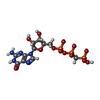
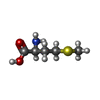





| #42: Chemical | ChemComp-MG / #43: Chemical | #44: Chemical | ChemComp-GCP / | #45: Chemical | ChemComp-MET / | #46: Water | ChemComp-HOH / | |
|---|
-Details
| Has ligand of interest | Y |
|---|---|
| Has protein modification | N |
-Experimental details
-Experiment
| Experiment | Method: ELECTRON MICROSCOPY |
|---|---|
| EM experiment | Aggregation state: PARTICLE / 3D reconstruction method: single particle reconstruction |
- Sample preparation
Sample preparation
| Component |
| ||||||||||||||||||||||||||||||||||||||||||
|---|---|---|---|---|---|---|---|---|---|---|---|---|---|---|---|---|---|---|---|---|---|---|---|---|---|---|---|---|---|---|---|---|---|---|---|---|---|---|---|---|---|---|---|
| Molecular weight | Value: 1.8 MDa / Experimental value: NO | ||||||||||||||||||||||||||||||||||||||||||
| Source (natural) |
| ||||||||||||||||||||||||||||||||||||||||||
| Source (recombinant) |
| ||||||||||||||||||||||||||||||||||||||||||
| Buffer solution | pH: 6.5 | ||||||||||||||||||||||||||||||||||||||||||
| Buffer component |
| ||||||||||||||||||||||||||||||||||||||||||
| Specimen | Conc.: 0.1 mg/ml / Embedding applied: NO / Shadowing applied: NO / Staining applied: NO / Vitrification applied: YES | ||||||||||||||||||||||||||||||||||||||||||
| Specimen support | Grid material: COPPER / Grid mesh size: 300 divisions/in. / Grid type: Quantifoil R2/2 | ||||||||||||||||||||||||||||||||||||||||||
| Vitrification | Instrument: FEI VITROBOT MARK IV / Cryogen name: ETHANE / Humidity: 100 % / Chamber temperature: 277 K |
- Electron microscopy imaging
Electron microscopy imaging
| Experimental equipment |  Model: Titan Krios / Image courtesy: FEI Company |
|---|---|
| Microscopy | Model: FEI TITAN KRIOS |
| Electron gun | Electron source:  FIELD EMISSION GUN / Accelerating voltage: 300 kV / Illumination mode: FLOOD BEAM FIELD EMISSION GUN / Accelerating voltage: 300 kV / Illumination mode: FLOOD BEAM |
| Electron lens | Mode: BRIGHT FIELD / Nominal magnification: 59000 X / Nominal defocus max: 3500 nm / Nominal defocus min: 1000 nm / Cs: 2.7 mm / C2 aperture diameter: 70 µm / Alignment procedure: COMA FREE |
| Specimen holder | Cryogen: NITROGEN / Specimen holder model: FEI TITAN KRIOS AUTOGRID HOLDER / Temperature (max): 100 K / Temperature (min): 90 K |
| Image recording | Average exposure time: 1.1 sec. / Electron dose: 30 e/Å2 / Detector mode: INTEGRATING / Film or detector model: FEI FALCON III (4k x 4k) / Num. of grids imaged: 8 / Num. of real images: 11245 Details: Images were collected in movie-mode at 30 frames per second |
- Processing
Processing
| EM software |
| ||||||||||||||||||||||||||||||||||||||||||||||||
|---|---|---|---|---|---|---|---|---|---|---|---|---|---|---|---|---|---|---|---|---|---|---|---|---|---|---|---|---|---|---|---|---|---|---|---|---|---|---|---|---|---|---|---|---|---|---|---|---|---|
| Image processing | Details: FEI Falcon III | ||||||||||||||||||||||||||||||||||||||||||||||||
| CTF correction | Type: PHASE FLIPPING AND AMPLITUDE CORRECTION | ||||||||||||||||||||||||||||||||||||||||||||||||
| Particle selection | Num. of particles selected: 1680000 / Details: Selected particles after 2d-classification | ||||||||||||||||||||||||||||||||||||||||||||||||
| Symmetry | Point symmetry: C1 (asymmetric) | ||||||||||||||||||||||||||||||||||||||||||||||||
| 3D reconstruction | Resolution: 3.35 Å / Resolution method: FSC 0.143 CUT-OFF / Num. of particles: 66519 / Symmetry type: POINT | ||||||||||||||||||||||||||||||||||||||||||||||||
| Atomic model building | B value: 123 / Protocol: OTHER / Space: RECIPROCAL / Target criteria: FSC | ||||||||||||||||||||||||||||||||||||||||||||||||
| Atomic model building | PDB-ID: 6FYX Accession code: 6FYX / Source name: PDB / Type: experimental model | ||||||||||||||||||||||||||||||||||||||||||||||||
| Refine LS restraints |
|
 Movie
Movie Controller
Controller










 PDBj
PDBj




































